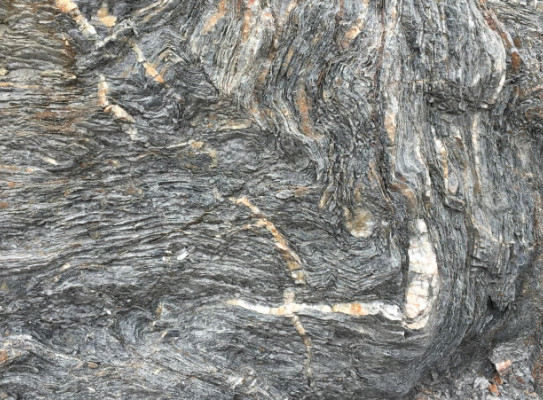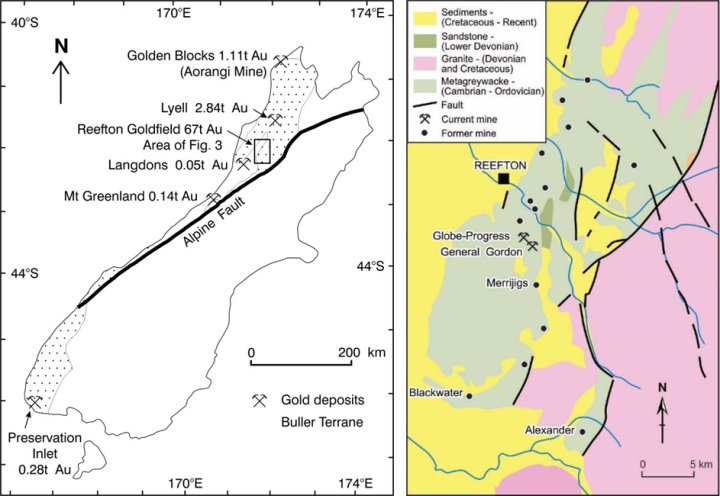Orogenic

The term orogenic gold describes a group of structurally controlled gold deposits formed in convergent margin settings. These systems are associated with low-salinity fluids, deposited at crustal depths generally ranging from 2 to 20 km world-wide.
Orogenic Gold Mineral System Model
The orogenic gold mineral system, based on Wyman et al. (2016) and Groves and Santosh (2023), is defined by four critical components that guide exploration efforts:
1. Fertility
Orogenic gold deposits originate from subcrustal, sulphur-bearing fluids rich in gold (Au) and trace metals (Ag, As, Bi, Sb, Te, W). These fluids are sourced from subducted oceanic crust and modified during their ascent. Key indicators include near-neutral, reduced fluids and geochemical proxies, such as sulphur isotopes, that hint at deep-seated origins.
2. Geodynamics
Deposits form in convergent tectonic margins linked to subduction processes. Fluid release occurs during slab devolatilisation, generating overpressured ore fluids that migrate upward via large-scale fault systems. These fluids are emplaced during transitions in tectonic stress, often late in the orogenic cycle.
3. Architecture
A robust plumbing system connects lithosphere to crust, enabling fluid migration. Key structural controls include lithosphere-scale faults, high-angle accommodation faults, and intersections with crustal shear zones. Secondary traps, such as tight folds, granite contacts, and permeable volcanic sequences capped by impermeable sediments, focus gold deposition.
4. Preservation
The preservation of deposits depends on their formation at depths of 2–5 km and their location in tectonically stable regions like craton margins. Thick, buoyant lithospheric keels beneath these areas enhance long-term preservation, while deposits in less stable regions may be lost to erosion or metamorphism.
Exploration Implications
- Look for ancient convergent margin indicators like volcanic arcs, turbidites, and accreted oceanic crust.
- Identify deep crustal structures using aeromagnetic, gravity, and magnetotelluric data, which highlight fluid conduits and structural traps.
- Focus on geochemical footprints, especially gold combined with As, Bi, Sb, Te, or W, to pinpoint potential targets.
Orogenic Gold deposits in New Zealand
Orogenic gold deposits in New Zealand occur in two schist belts – 1. the Paleozoic and 2. the Mesozoic schists. These deposits are typically characterised by their association with regional metamorphism, deformation, and faulting. The gold is commonly found in quartz veins and is associated with sulphide minerals and sometimes by-products such as W and Sb. The deposits are typically of mesothermal (moderate depths of < 12 km and moderate temperatures) origin, forming during orogenic events ).
Paleozoic Orogenic Gold Deposits
Paleozoic gold deposits are primarily found in the Buller terrane on the West Coast. These deposits formed between 375–350 Ma during regional metamorphism and deformation. Gold is hosted in quartz veins within greenschist -facies rocks, commonly associated with arsenopyrite and pyrite.
Key characteristics:
- Hosted in greywacke, argillite and slate all metamorphosed to lower greenschist facies.
- Hydrothermal alteration resulting in secondary sericite, carbonate, arsenopyrite and pyrite.
- Structurally controlled within steeply dipping, fault-related quartz veins in shear zones.
- Gold commonly associated with arsenopyrite and pyrite.
- Typically high-grade but small-tonnage deposits.
- Examples: Reefton Goldfield, Lyell Goldfield, and Golden Blocks.
Reefton Goldfield (West Coast)
- One of New Zealand’s largest historical gold-producing areas, yielding 2 Moz Au since the 1870s.
- Hosted in Ordovician Greenland Group metasediments.
- Mineralisation occurs in steeply dipping quartz veins within reverse faults and shear zones.
- Gold grades typically range from 5–20 g/t Au, with some veins exceeding 100 g/t Au.
- Modern mining at Globe-Progress (2006–2016) extracted 700,000 oz Au at ~1.8 g/t Au.
- Strong exploration potential remains for deeper extensions and blind deposits. At the Blackwater/Snowy River project, with a historical production of 750,000 oz Au (1906-1951), a JORC resource of 785,000 oz Au has been identified by Federation Mining and Siren Gold identified a JORC resource of 170,000 oz Au (2023) at Alexander.

Mesozoic Orogenic Gold Deposits
Mesozoic deposits formed during the 150–100 Ma collision of Zealandia with the paleo-Pacific plate. These are the largest orogenic gold systems in New Zealand and occur mainly in the Otago Schist of the Caples and Torlesse terranes.
Key characteristics:
- Hosted in greenschist-facies schist, mylonite, and cataclasite.
- Hydrothermal alteration resulting in secondary chlorite, carbonate, sericite, arsenopyrite and pyrite (graphite at Macraes).
- Gold occurs as fine-grained disseminations in sheared schist and quartz veins.
- Mineralisation is controlled by regional shear zones and thrust faults.
- Typically, lower-grade but high-tonnage compared to Paleozoic deposits.
- Examples: Macraes, Rise & Shine, Bendigo, and Barewood deposits.
Hyde-Macraes Deposit (Otago)
- New Zealand’s largest active gold mine, producing over 5 Moz Au since 1990.
- Hosted in the Hyde-Macraes Shear Zone, a 30 km long shallow-dipping shear zone up to 250 m thick.
- Gold occurs associated with arsenopyrite and pyrite in sulphide-rich mylonites, sheared schist, and quartz veins. Scheelite is abundant in some quartz veins.
- Grades: 1.0–1.3 g/t Au, but large-scale mining makes it economically viable.
- Hydrothermal mineralisation formed at 135 Ma from metamorphic fluids (Mortensen et al., 2010).
- Ongoing exploration is extending known resources at depth and along strike.
Rise & Shine Shear Zone (Otago)
- A high-grade, structurally controlled gold deposit hosted in the Otago Schist.
- Gold occurs in quartz veins within a 50 m thick shear zone dipping 20–50°.
- Truncated by the post-mineralization Thompsons Gorge Fault.
Recent exploration drilling has identified high-grade zones averaging 5–10 g/t Au, with some intercepts exceeding 30 g/t Au. An interim JORC Resource of 2.45 Moz was identified by Santana Minerals in May 2024.

Exploration Potential
Both Paleozoic and Mesozoic deposits remain highly prospective, with modern exploration revealing new targets in underexplored areas. Advances in geophysical surveys, structural mapping, and geochemical techniques are aiding in identifying deeper and previously overlooked mineralisation.
For explorers, understanding the structural controls, metamorphic fluid evolution, and lithological influences on gold deposition is key to unlocking New Zealand’s orogenic gold potential.
Use our web map(external link) on the orogenic mineral system to see the location of some key geologic features used for exploration.
Definition and Classification
Traditional Crustal Metamorphic Model:
The traditional model for orogenic gold deposits suggests gold deposition results from the metamorphic devolatilisation of supracrustal rocks under greenschist-to-amphibolite facies conditions. Fluids migrate upward along structural pathways, depositing gold during late stages of deformation (e.g., compression).
Challenges in Precambrian and Phanerozoic Settings:
- Hypozonal deposits in Precambrian terranes (e.g., Western Australia) suggest a deeper fluid source, possibly from subcrustal reservoirs.
- Phanerozoic mesozonal (6-12km) to epizonal (<3 km) deposits often align with the traditional model, but some require alternative explanations involving mantle-derived fluids and metasomatism. For example, gold systems in China (e.g., Jiaodong Province) reflect mantle lithosphere metasomatism followed by asthenospheric upwelling during tectonic events like subduction and lithosphere delamination.
Holistic Genetic Model:
A universal model must integrate crustal and subcrustal processes, considering:
- Metamorphic fluid generation for mesozonal-epizonal deposits.
- Mantle-derived fluids for hypozonal systems, often tied to deep-seated tectonic processes.
- Geodynamic diversity (e.g., subduction, delamination, and asthenospheric upwelling) as drivers of fluid mobilisation and gold deposition.
References
Allibone (2017) - Structural Setting of Gold Mineralization within the Hyde-Macraes Shear Zone, Southern New Zealand
Allibone (2020) - Structural settings of gold deposits within the Reefton goldfield, western New Zealand
Christie (2019) - Introduction to New Zealand hard rock gold deposits and their exploration models
Christie (2002) - Mesothermal gold deposits in New Zealand : mineral deposit model
Groves, D. I. and M. Santosh (2023). Mineral systems, earth evolution, and global metallogeny. ISBN: 9780443216848
Wyman, D.A., Cassidy, K.F., and Hollings, P., 2016, Orogenic gold and the mineral systems approach: Resolving fact, fiction and fantasy: Ore Geology Reviews, v. 78, p. 322–335.